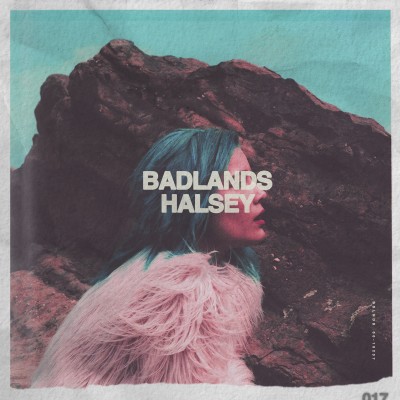On “New Americana,” singer-songwriter Halsey explores contemporary society’s elimination of walls, evolution of conventions and blending of cultures.
The woman rolling with Rockefellers is not there courtesy aid from old money or a powerful husband but as an independently successful dreamer who built her own empire. The football player may resemble society’s traditional all-American boy, but he is gay, out and married.
We smoke legal marijuana, and we jointly draw inspiration and influence from Biggie and Nirvana.
The spirit at the core of this “New Americana” is Halsey’s driving force as an artist. It also powers her superb debut album BADLANDS.
Attempting to neatly characterize–let alone stereotype–Halsey is a fool’s errand. This is an artist who possesses a massive, superstar presence but an utter absence of bombast. Her voice is restrained and delicately affected but still weighty enough to fill even the biggest stadium. She is deeply connected to her art but not remotely pretentious. She explores dark emotion with a brooding demeanor but remains youthfully enthusiastic at all turns. Her sound can evoke the stylings of Lorde, Lana Del Rey, BANKS and Sky Ferreira but also demonstrate clear resemblance to glossier pop-rock acts like Imagine Dragons.
The only clear, undeniable truth — one proven by the millions of social followers she has amassed without conventional exposure, the way she owns the room when performing on stage and the extent to which her music emotionally and spiritually captivates listeners whenever it spins — is that Halsey is a bona fide superstar.
BADLANDS is a debut album befitting that truth.

The latter descriptor is a decidedly rare phenomenon in today’s music world.
The music industry possesses enough songwriting, production and vocal talent to churn out albums upon albums of great pop songs, but few of those albums perfectly capture the intricacies of the associated artist. Few (regardless of whether the artist was involved in the songwriting) feel as if their tracks could have only been properly recorded by a specific artist or as if their message could have only been properly communicated by a specific voice.
BADLANDS exists within that rarefied air of being musically great and immensely personal.
It is not as if this album would be a bad one in different hands. The production is consistently captivating, the instrumentation is alluring, the melodies are gorgeous and the hooks are intoxicating. This is a fundamentally strong collection of music.
But what makes it worthy of a celebratory review (and of the monstrous industry and fan enthusiasm) is not the objective quality of its music. It is the way it simultaneously suits and organically presents the talented Halsey.
It paints a vivid picture of the rising star, and it places the listener deeply inside her “Badlands” universe/mindset.
Across each intricately produced, yet unflinchingly soaring track, Halsey captures the listener’s heart and attention. No matter her intent – to seduce, to expose her vulnerability, to express her disillusionment or to assert her confidence – the artist uses the right combination of vocal dynamics, lyrical frankness and compositional mastery to make her case.
No matter how theoretically conflicting on paper, the album’s sonic and contextual facets consistently unite to present Halsey’s intended message with her intended energy from her intended perspective. Human emotion is not simple, and this album is very mindful of that.
Instead of adhering to rigid conventions – and inevitably compromising her identity in that process – Halsey finds the sonic and lyrical combinations that work for her. The truth of her identity and the sincerity of her message defines the sound of BADLANDS. It is not defined or restricted by that sound.
Every note of every song is a piece of her. That reality is what allowed Halsey to cultivate her passionate fanbase, and it is what will allow BADLANDS to continue that rapid ascent into superstardom. By combining the personal, conversational, emotional elements of today’s alternative scene with the personality, breadth and energy of today’s mainstream scene, BADLANDS presents Halsey as an artist who can be dark and unique without being boring; and as an artist who can be poppy and accessible without being pulpy and soulless.
![The truth of her identity and the sincerity of her message defines the sound of BADLANDS...every note of every song is a piece of her [Cr: ABC]](https://headlineplanet.com/home/wp-content/uploads/2015/08/Halsey-Kimmel-267x400.jpg)
It also results in a unique — and engaging — lyrical tone.
Whether directly confronting norms and constraints in songs like “Castle” or “Hold Me Down,” celebrating diversity on “New Americana” or overcoming reluctance on “Drive,” Halsey reveals that her aversion to boxes and pigeon holes is one of sincerity. It is not a tactic to make the album sound cool – it is a means of making the album sound like her.
The contrast often does, of course, sound very cool. On “Roman Holiday,” Halsey sings intimately descriptive lyrics with a frank, conversational tone over bright, soaring pop production. The result is a transcendental musical experience — and the best track on an album full of complex, yet accessible pop gems.
Whereas many albums tend to venture into experimental territory late on the tracklist, BADLANDS adheres to the reverse. Save for album closer “Ghost” (which is an early Halsey signature), the tracklist is arranged chronologically based on when she wrote each song. As a result, the last few songs — reflective of her getting into a natural groove – bear more overt similarity.
That similarity does not, however, signify emotional or sonic redundancy. Halsey attacks each song from a unique perspective, and she and the other writers and producers consequently give each song an identity unique enough to convey that perspective. Songs like “Haunting” and “Young God” may sound more superficially similar than do “New Americana” and “Castle,” but they still stand entirely on their own. They are not repetitive, and they are not unnecessary.
The early songs, meanwhile, remain very connected even when separated from a superficial sonic standpoint. Because every element of every song is an authentic extension of Halsey’s personality, the entire album comes across as a unified body of work and as a unified introduction to an artist with immense clarity of who she is and what she wants to say.
While Halsey has spent many months cultivating a ‘queen’ image with young social media users, she recently — thanks to monstrous ticket sales, massive pre-order interest in BADLANDS and the release of instantly resonant single “New Americana” — exploded onto the radar of music business analysts and tastemakers. Craving simplicity, these individuals have been working tirelessly to explain her rise to fame.
When they enter the “Badlands” – and witnesses an artist who not only knows who she is but can successfully present that identity across an album’s worth of ambitious, yet easily accessible tracks – they will not simply cease asking the question. They will join the passionate fanbase.
Available as an eleven-track standard edition (the one issued to critics) or a sixteen-track deluxe edition, Halsey’s BADLANDS arrives on August 28.
- Castle
- Hold Me Down
- New Americana
- Drive
- Roman Holiday
- Colors
- Coming Down
- Haunting
- Control
- Young God
- Ghost





